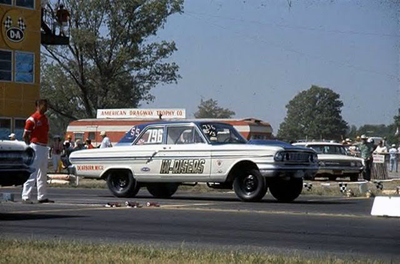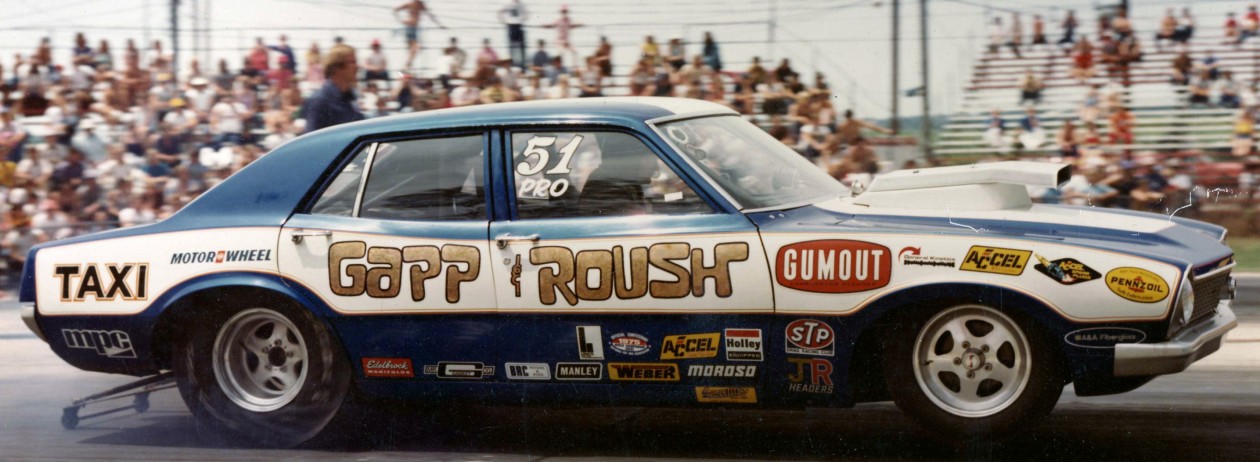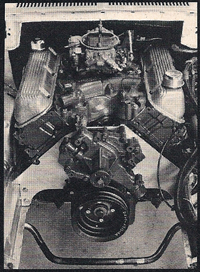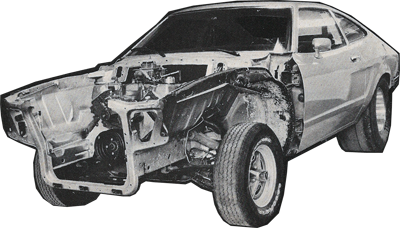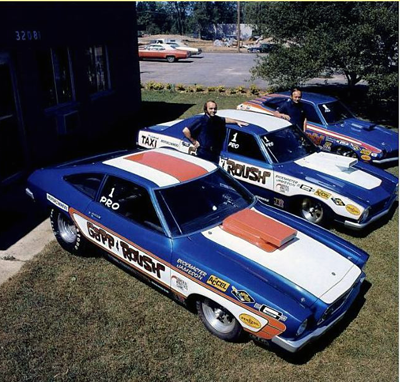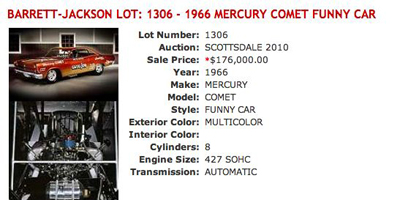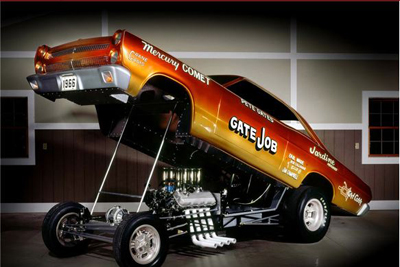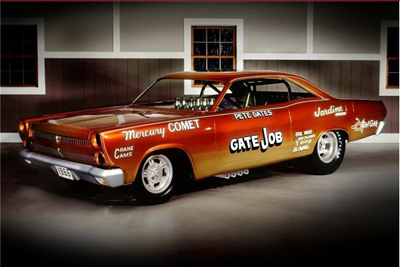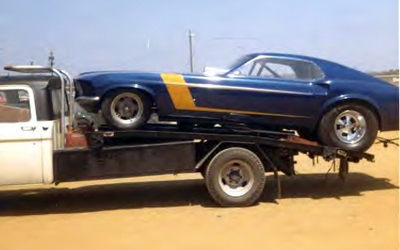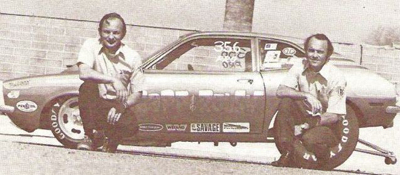PRO STOCK ELIMINATOR

PRO STOCK ELIMINATOR – 1972 National Champion, (far lane), Ray Allen
Reserved for American built cars with American automobile engines with a wheelbase of 100 inches or more and for American sub-compacts.- AMX, Colt, Cricket, Gremlin, Pinto or Vega – with American engines with a minimum wheelbase of 94 inches. Body, engine, drive train, chassis, etc., may not be altered, modified or relocated, except as outlined in Class Requirements. Push starts not permitted. One class of competition for non-supercharged cars. Class is determined by total car weight divided by total cubic inches engine displacement.
DESIGNATION: PRO, preceded by car number.
- 6.50 or more lbs. per cubic inch, for original “true wedge” or incline valve engines.
- 7.00 or more lbs. per cubic inch, for all other engines.
Displacement/weight ratios subject to re-evaluation March 19, 1973
CLASS REQUIREMENTS
BALLAST: Permitted. Maximum of 120 lbs.
BATTERY: Trunk installation permitted. Two maximum. Total weight wet and fully charged, including battery box: 100 pounds
BODY: Must be a 1969 or later model/year factory produced coupe, sedan or station wagon. Sports Cars, Sedan Deliveries and Trucks not permitted. Original steel body shell must be retained. The use of fiberglass or other lightweight components is restricted to hood, front fenders, splash pans, valance panels and rear deck lid, however, they must be exact duplicates of stock components replaced. Lift-off hoods and deck lids permitted. Excessive weight reduction of bodies or body parts is not permitted. Roll cages mandatory. Any under the hood modification necessary for engine installation will be allowed. See Firewall.
BRAKES: Four-wheel brakes mandatory.
BUMPERS: Stock front and rear bumpers with guards or exact fiberglass duplicates with proper bracing are required.
CARBURETION: Limited to two 4-bbl or four 2-bbl American automotive carburetors with any internal modifications. Fuel injectors not allowed.
DRIVELINE: May be modified or fabricated to fit altered units. See Safety Regulations, Drivelines.
DRIVER: Must be in stock location. Revision of seat location prohibited.
ENGINE, 100 lnch Wheelbase 0r More: Must be of 1965 or later manufacture and must be the same make as car. Any internal modifications permitted. Minimum total car weight, 2,400 lbs.
ENGINE, Less than 100 Inches Wheelbase: Must be of 1965 or later passenger car production, the same make as car, with original displacement 366 inches or less. Any internal modifications permitted. Minimum allowable weight 2,100 lbs.
ENGINE SET BACK: Permitted, provided the front spark plug hole is not behind the front spindle.
EXHAUST SYSTEM: Open exhaust with headers, permitted. Tailpipes and/or mufflers optional. Outlets for open exhausts cannot exceed 4 inches in diameter.
FENDER SPLASH PANS: Must be retained, cannot be removed, but can be trimmed to allow a maximum of 2 inch clearance around headers. The use of aluminum or fiberglass for fender splash pans is allowed.
FIREWALL: Moving the stock firewall rearward for engine installation permitted. Replacing the stock unit with one of .028 inch steel allowed
FLOORS: Replacing the stock floors with .028 inch steel allowed.
FLYWHEEL/CLUTCH: Use of stock type, cast iron flywheels and/or pressure plates prohibited. Explosion-resistant units required.
FLYWHEEL SHIELD: SEMA 6-1 flywheel shield required on all cars except those equipped with pre-1961 Hydramatic transmissions. Minimum requirement for all other automatic transmissions is an accepted flexible blanket shield. See Safety Regulations, Flywheel Shields.
FUEL SYSTEM: Original stock type fuel tank must be used. If filler neck is relocated into trunk the tank must have a pressure cap and tank must be vented to the outside of the body. Trunks must then be completely isolated from the driver’s and passenger compartment with a suitable firewall of flameproof material. Accessory tank(s) not permitted. Fuel blocks acceptable. See Safety Regulations, Fuel Systems.
FRAME: Must be stock automobile frame for car body used. Properly reinforced stepped frames accepted. Cross members may not be altered or relocated except as required for engine or transmission swaps. Additional members may be added for strength for roll cage installations. See Roll Cage.
GRILLE: Grilles must be full stock production for the body used.
HELMET: Required, all classes.
HOOD SCOOP: Permitted, however hood scoops other than ones produced as factory equipment for the specific model and year of car may not extend more than 7 inches above the height of the original hood’s surface, as measured from the base of the hood scoop for cars with a wheelbase of 100 inches or more. Maximum height is 5 inches on any car with a wheelbase less than 100 inches. All scoops must be finished and painted to follow the body paint scheme.
RADIATOR: Full size stock radiator in stock location required.
REAR END: Stock type rear end required.
ROLL CAGE: Required. May be constructed of SAE 4130 Chrome Moly steel or l% inch X .095 inch dimensions. All welding must be done by approved Heliarc process. Additional frame strengthening members must be of same dimensions and welding as roll cage.
SAFETY BELT & SHOULDER HARNESS: Required. lt is highly recommended that a five point or inverted ‘V’ belt be used.
SPOILERS: All rear spoilers other than those originally factory installed on body used must not be more than four inches high and must be mounted behind the rear axle. Roof mounted spoilers other than original for body used not permitted. No air foils allowed. Any rear spoiler must be integrated into the overall body design and be painted to match the body color scheme.
STEERING: Stock type steering located in the conventional stock location required.
STREET EQUIPMENT: Any street equipment which does not affect the external appearance of the car may be removed, except head and tail lights.
SUSPENSION: Stock front suspension for the car body used must be retained. Full automotive type rear suspension required. Rigid rear axle not permitted.
TIRES: Slicks permitted. Rear tire tread may not exceed two inches outside the rear fenders and rear fenders must retain the original contours.
TRACTION BARS: Traction bars or similar devices used to transmit rear axle torque to the frame, thus preventing violent rear end wind-up under acceleration or deceleration, are considered safety equipment and are therefore highly recommended. However, units must not be longer in overall length than one-half the wheelbase of the car. Traction bars and/or mounting brackets to the rear axle housing must not be lower than the lowest edge of the rear wheel rim.
TRANSMISSION: Any transmission acceptable with forward and reverse gears. Transmissions must remain in conventional location, determined by engine used. Manual clutch automatic transmissions are permitted.
UPHOLSTERY: Full interior trim must be retained equivalent to factory specifications. Bucket seats may replace stock seats (two required only if they are fully upholstered and full size automotive type seats. Dashboard exterior appearance must be retained.
WHEELBASE: All cars must retain stock wheelbase, length and tread width for car body used. All Pro class cars may not have a wheelbase variance from left to right of more than one inch. Any alteration to the wheelbase, front and/or rear overhang, relocation of the wheelwells and/or axle relocation is prohibited.
WINDSHIELD/WINDOWS: Full safety glass required. No plexiglass or other lightweight components. All windshields and windows must be clear except for factory tinted safety glass. Identification decals not permitted on any front door window or windshield. Windows must be closed; windows need not be operative.
